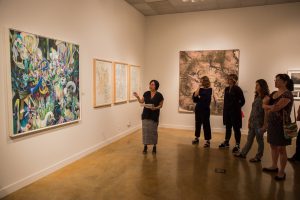By Olivia Lee
 From August 29 to September 29, the Thompson Art Gallery is featuring the Pictorial Arts Faculty Exhibition. This exhibition showcases works by Jason Adkins, Gale Antokal, Irene Carvajal, Robert Chiarito, Donald Feasel, Erik Friedman, Patrick Surgalski, and Matthew Taylor. All currently teach in the Department of Art and Art History.
From August 29 to September 29, the Thompson Art Gallery is featuring the Pictorial Arts Faculty Exhibition. This exhibition showcases works by Jason Adkins, Gale Antokal, Irene Carvajal, Robert Chiarito, Donald Feasel, Erik Friedman, Patrick Surgalski, and Matthew Taylor. All currently teach in the Department of Art and Art History.
The exhibition allows students the opportunity to view the personal and professional artwork of their professors.
“It is of significant pedagogical value for students to see this show,” says Professor Jo Farb Hernández, Gallery Director and Curator, “not only because the teacher-scholar model of faculty pursuing work in their fields sets an important example, but because students may discover that their professors’ artwork differ substantively, in aesthetic and technique, from what they teach in the classroom.”
Many pieces in the exhibition exemplify Hernández’s view, particularly Professor Feasel’s work, which Feasel describes as “chance-derived paintings”—paintings that are highly dependent and driven by circumstance. His two acrylic paintings are based on evaporation and veer away from the traditional still-life paintings he produces and teaches in class. He submerged raw canvases in mixtures of water and pigment, draped and let the canvases dry for days, and eventually ended up with shapes that are hard to define.
Feasel considers his method to be “more like setting up a lab where things could happen, but maybe nothing will.” Although his unconventional process does not involve laborious planning through sketches and studies of a subject, his work presents its own set of challenges.
“When I see my own painting, I get this same surprise of someone just walking in would,” Feasel says. Because the results in his painting are often unexpected, Feasel finds it difficult to “care” about his work; thus, he usually ends up with many castaways. “My criteria for keeping a painting is that it has to keep your interest when you look at it,” Feasel says, “but none of this is very rational—something that is not really taught in class.”
While pieces like Feasel’s paintings may uncover a hidden side of a professor’s works to students, the exhibition also reveals “the extremely wide range of aesthetic, media, and technique that is manifested by the different artists,” Hernández says.
Professor Gale Antokal’s work, for instance, drastically differs from Feasel’s paintings despite being in the same pictorial genre. Although Antokal’s pieces are drawings, her work evokes the traditions of drawing, painting, and photography all at once.
“My visual source is frequently photographed at 1/1000 sec. Then, I photoshopped the pictures to obscure fact: day can be changed to night; shapes shift due to fog; and what is seen and obliterated moment by moment, day to day—a fiction of time. This immediacy is laboriously transformed as I draw the resultant work and collage the single frames to create interesting movement,” Antokal explains.
Her creative process is interdisciplinary and not at all a typical drawing process. She paints layers of graphite emulsified in mineral spirits onto Yupo synthetic paper. The graphite is then burnished to a mirrored surface. She makes her drawings through the process of erasure, removing the graphite with solvent, scotch tape, and steel wool to reveal light and a range of tone.
“The results are drawings with the look of daguerreotypes, early pictorialist photography, 50s peel-apart polaroids, and most recently, panoramic film strips,” says Antokal.
Although the source of her drawings lies in photography, Antokal has obscured the original photos to the point where the images are “no longer facts,” allowing her work “to raise the question of what is real and what is perceived as real.”
 Overall, the artworks by each artist are distinct from one another because the exhibition is not restricted by a theme based on subject or medium. This freedom allows artists to explore different issues through different means.
Overall, the artworks by each artist are distinct from one another because the exhibition is not restricted by a theme based on subject or medium. This freedom allows artists to explore different issues through different means.
For instance, Professor Irene Carvajal’s two paintings incorporate “mundane, everyday objects” through techniques of screenprinting and monoprinting. “I create collagraphs out of discarded clothing of mass production, and I run them through the press machine,” Carvajal says. “I also make screenprints of patterns produced in textile factories from Bangladesh, Costa Rica, and other countries that participate in mass producing clothing.”
The images in her work are truly ubiquitous, as she even utilizes a clothing iron to burn shapes directly onto her canvas. Carvajal’s method of printmaking allows her to examine the relationship between mass-produced images and the culture of consumerism: “I am interested in looking at value—the value of print, of anything that is mass produced—and what the real value/cost of mass production is, to not just you and me in this globalized economy, but also to the people who are producing these things.”
Not all artists in the exhibition, however, ground their work in the materialistic realities of the world. Many artists focus on exploring abstract and aesthetic issues of beauty, artistic composition, and how they relate to the human psyche.
“Under most circumstances, it would be unlikely for these artists and/or works to be curated into the same exhibition due to the range of scale, media, technique, and aesthetic intention,” Hernandez says, “but this makes for a terrific academic program as it allows students to learn from a range of viewpoints.” Thus, the sheer variety of artwork featured in the gallery makes the exhibition unique and exciting.
So come by the Thompson Art Gallery and see the Pictorial Arts Faculty Exhibition—admission is free and the gallery is open daily.
For more information about the exhibition, visit http://events.ha.sjsu.edu/art/events/pictorial-arts-faculty-exhibition/

